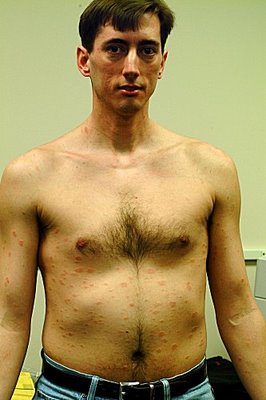Pityriasis rosea
__NOTOC_ Template:DiseaseDisorder infobox Template:Search infobox Editor-In-Chief: C. Michael Gibson, M.S., M.D. [1]
Overview
Pityriasis rosea is a skin disease marked by patches of pink, oval rash. Although its exact cause is unknown and its onset is not linked to food, medicines or stress, it is thought that this essentially non-contagious condition is set off by a virus. Pityriasis rosea can affect members of either sex of any age. However, it is most common in females and those between the ages of 8 and 35. Symptoms only recur in 3% of the affected.
Diagnosis
Symptoms
The symptoms of this condition include:
- Pink and flaky oval-shaped rash, similar to ringworm
- A single "herald" patch may occur 1 to 20 days before smaller, more numerous patches of rash. It has also been known for the "herald" patch either not to be noticed or not to exist. Other "herald" patches may appear as a cluster of smaller oval spots rather than a single patch.
- Often occurs in patches arranged in a triangular pattern, like a "Christmas tree"
- 25% of people with Pityriasis Rosea get mild to severe itching. This fades as the rash develops
- May be accompanied by headache, fever, nausea and fatigue
- Other less common symptoms include reduction in sweat gland activity and the clearance of acne
These rashes are often found on the back, chest / stomach, inner thighs, inner upper arms and inner forearms. It has been seen occasionally on the palms of the hands. Usually it does not affect the face; however a few blemishes may be found on the cheeks.
Physical Examination
Skin

Treatments
Although there is no cure for pityriasis rosea, in most cases the condition goes away by itself without any treatment. Ultraviolet light treatment or phototherapy may shorten the duration of the condition and may be prescribed for extensive and persistent cases of pityriasis. Corticosteroid creams may also be prescribed to relieve the itching.
Pityriasis rosea usually lasts between 8 to 10 weeks — the rashes disappear without scarring. In people with dark complexions, however, hyperpigmented discolorations may last for several months afterwards.
Although Pityriasis rosea may occur in more than one person in a household at a time, it is not thought to be highly contagious.
Dogs and bears are known to be afflicted by Pityriasis rosea quite frequently
See also
- Ringworm
- Pityriasis - for list of similarly named flaky skin conditions
References
External links
- HealthInPlainEnglish - Pityriasis rosea
- Template:DermNet
- Links to pityriasis rosea pictures (Hardin MD/Univ of Iowa)
- Go Ask Alice Health Advice from Columbia University